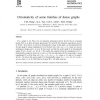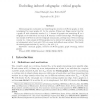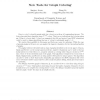6 search results - page 1 / 2 » Chromaticity of some families of dense graphs |
88
Voted
DM
2002
15 years 19 days ago
2002
For a graph G, let P(G; ) be its chromatic polynomial and let [G] be the set of graphs having P(G; ) as their chromatic polynomial. We call [G] the chromatic equivalence class of ...
111
Voted
WG
2005
Springer
15 years 6 months ago
2005
Springer
In this paper, we present a new algorithm for computing the chromatic polynomial of a general graph G. Our method is based on the addition of edges and contraction of non-edges of ...
107
click to vote
RSA
2011
14 years 7 months ago
2011
Determining the cardinality and describing the structure of H-free graphs is wellinvestigated for many graphs H. In the nineties, Prömel and Steger proved that for a graph H with...
132
click to vote
APPROX
2011
Springer
14 years 24 days ago
2011
Springer
How to color 3 colorable graphs with few colors is a problem of longstanding interest. The best polynomial-time algorithm uses n0.2072 colors. There are no indications that colori...
100
click to vote
JSYML
2010
14 years 7 months ago
2010
A set A of vertices of a graph G is called d-scattered in G if no two d-neighborhoods of (distinct) vertices of A intersect. In other words, A is d-scattered if no two distinct ver...



